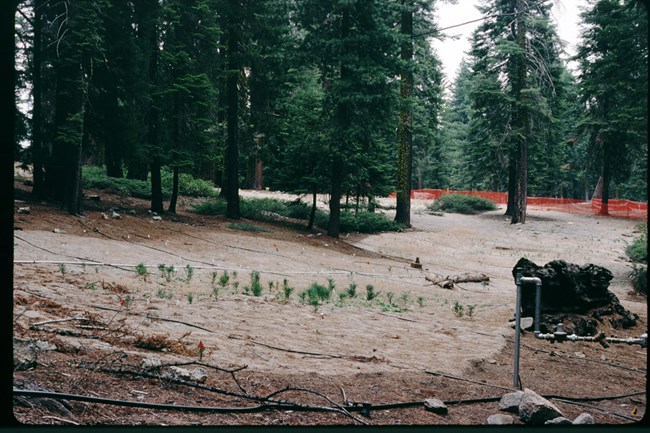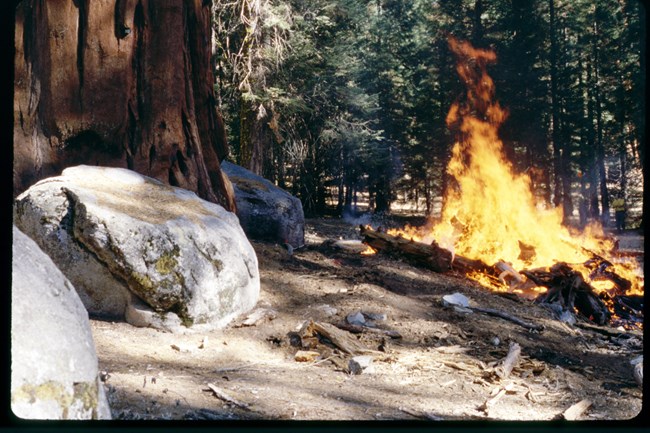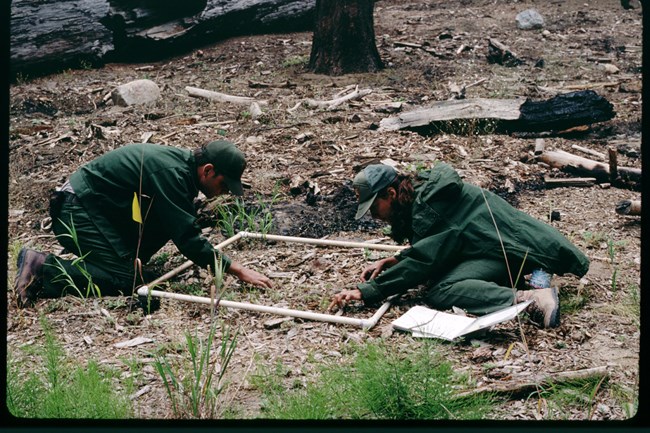Restoration GoalsDevelopment in Giant Forest altered the vegetation in several ways. Trees were cleared for buildings and parking lots, leaving distinct openings in the forest canopy. The forest overstory was thinner because trees that threatened human safety and property were removed. Trampling and soil compaction reduced or eliminated the forest understory, including grasses, wildflowers, shrubs, and tree seedlings. The soil seed bank, which influences the regenerative potential of the forest, was likely depleted. Small patches of wetland vegetation were lost where fill was placed over meadow edges or streams. 
NPS photo To restore the vegetation, ecologists looked to nature for a disturbance condition that resembled the disturbance caused by human development. In Giant Forest Village, the forest structure was a matrix of mature canopy interspersed with openings, or gaps, where patches of trees were cleared for buildings and parking lots. This condition was similar to surrounding areas of Giant Forest where natural, prescribed fire had killed patches of mature trees, creating openings, or gaps, in the canopy. These fire-caused gaps were colonized by patches of abundant shrub and tree regeneration, particularly giant sequoia, with little regeneration beneath intact canopy. Because gaps caused by fire are of similar size to gaps caused by human development, the vegetation growing within them can be used as a model, or reference condition, for restoration treatments. For treatments involving planting, mimicking the effects of fire is a particularly appropriate model because planting methods --within gaps only, during a short time period, with one to two year-old seedlings-- are similar to the pulse of regeneration occurring within gaps shortly after fire. This reference condition was quantified in 1994 by mapping and measuring woody vegetation in 18 fire-caused gaps in Giant Forest, 7 to 15 years following fire. Gap size was found to account for a significant amount of variability in density, growth rate, and/or cover of pioneer-type tree and shrub species. Learn more about how a natural disturbance model was developed to guide the Giant Forest vegetation restoration (231 KB, PDF format) about the use of fire-caused gaps as a natural disturbance model for restoration. To summarize, the short-term goal of vegetation restoration in Giant Forest Village is to reproduce the species composition, density, and spatial pattern of regeneration that would result from a natural fire event. The long-term goal is to integrate the site into the natural fire regime typical of surrounding areas of Giant Forest. In other words, park managers are putting in place a structure known to be within the range of natural variability, then allowing natural processes to thin the vegetation. By ensuring a vegetation structure similar to surrounding sites after one fire, park staff maximizes the success of this integration. Active Restoration or Natural Regeneration?Because of the duration and severity of changes in developed areas, park managers believed that some degree of human intervention was necessary for the recovery of soils and vegetation in Giant Forest Village. Evidence for this view lies in some formerly developed areas within the grove that were abandoned over 30 years ago and show little natural recovery. However, it was also hypothesized that an acceptable restoration of vegetation might be achieved through less intensive and intrusive means than the seed collection, propagation, planting, seeding, and irrigation process traditionally practiced in the park’s frontcountry revegetation projects. To address this possibility, an adaptive management approach was taken. The goal of adaptive management was to apply different degrees of active restoration in an experimental manner to determine the minimal intervention necessary to meet the reference condition: natural vegetation in fire-caused gaps. 
NPS photo - Athena Demetry Three levels of vegetation restoration in Giant Forest Village were tested, in order of increasing human intervention: 1) Restore Soil Only. 
NPS photo - Athena Demetry During the restoration project, more than 7275 trees, 4500 shrubs, and 5395 grasses and wildflowers were planted, and 22 pounds of seed were sown. The goal was to restore a total of 27 acres in Giant Forest. The vegetation resulting from these treatments was monitored to compare success. First-year monitoring results comparing treatments 2 (burn) and 3 (plant) suggested that both treatments will would be successful in producing similar numbers of trees and shrubs as the fire-caused reference gaps 10 years after fire. However, the planting treatment has accelerated the recovery process, with planted gaps having significantly higher plant cover area (that is, the plant canopies were larger and taller tree seedlings than burned gaps). Learn more about sequoia grove restoration (1,131 KB, PDF format) discussing monitoring in detail, including a table of survival rates of planted stock. Photopoint monitoring of these three treatment sites is.indicated that four years after restoration, Treatment 1 (soil restoration) continued to show slow vegetative recovery. Treatment 2 (burn) vegetation showed very rapid growth, perhaps exceeding the planting treatment. Treatment 3 (plant) vegetation was surviving well, but generally showed slower growth than the burn treatment. |
Last updated: October 16, 2023
